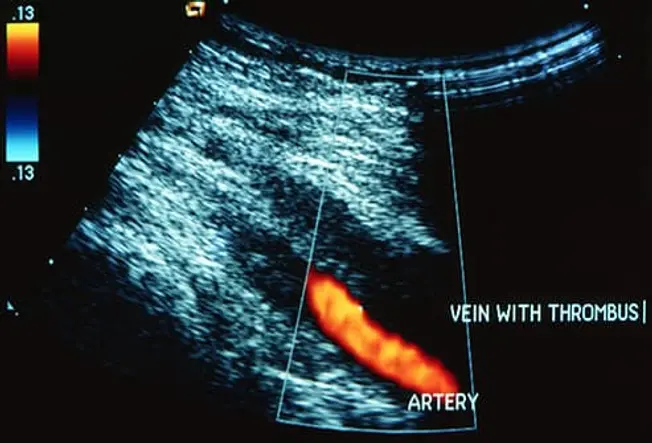Deep Vein Thrombosis (DVT): Signs, Symptoms, Causes & Prevention
Share IT

Launch Your Dream Website with Us!
Click Here to Get in touch with Us.
Categories
Deep Vein Thrombosis (DVT)
Thrombosis in Deep Veins (DVT): Recognising the Risk of Clots in Your Veins
When a blood clot forms in a deep vein, generally in the legs, it can lead to a dangerous condition called deep vein thrombosis (DVT). DVT is less common than blood clots in arteries, but if treatment is not received, it can be fatal.
How Does DVT Form and What Is It?
Deep Vein Thrombosis (DVT)
In order to return blood to the heart, our bodies rely on an intricate network of veins. Most blood returned to the heart is carried via deep veins, which are found deep inside muscular tissues. Blood cells may aggregate and form clots in these veins when blood flow slows down or stops. DVT is characterised by this clot.
Table of Contents

DVT symptoms and indicators
Deep Vein Thrombosis (DVT)
Sometimes DVT goes undetected, especially in its early stages. However, prompt diagnosis and treatment depend on being aware of the possible symptoms and signs:
- Abrupt swelling: Suddenly, one leg—typically the calf—may enlarge substantially more than the other.
- Pain: You may have throbbing or cramping pain, which usually becomes worse with movement and is most common in the calf or behind the knee.
- Tenderness: It may be difficult to touch the afflicted area.
- Skin discoloration or redness: Although less frequent, the skin surrounding the clot may seem red or discoloured.
Warmth: To the touch, the affected area may feel warm.
Deep Vein Thrombosis (DVT)
It’s crucial to remember that other illnesses may possibly be the source of similar symptoms. If you encounter any of these symptoms, particularly if they appear quickly and are limited to one leg, get help right once to rule out DVT and get the right diagnosis.
Risk Elements of DVT
Deep Vein Thrombosis (DVT)
There are several things that can make you more likely to get DVT. Among them are:
- Prolonged immobility: Prolonged sitting or lying down can slow down blood flow and raise the risk of clotting. Examples of these situations are lengthy flights and recovery from surgery.
- Recent hospitalisation or surgery: Particularly if it involved major surgery or extended bed rest.
- Medical conditions: A number of illnesses, including cancer, heart disease, and chronic inflammatory diseases, might raise the chance of clotting.
- Birthing and pregnancy: Due to hormonal changes and increased vein pressure, DVT risk can increase during pregnancy and the postpartum period.
- Obesity: Due to the sluggish blood flow that obesity and overweight can cause, these conditions can raise the risk of DVT.
- Smoking: Smoking weakens the walls of blood vessels and raises the chance of clotting.
- DVT in the family history: A close relative with a history of DVT raises your personal risk.
DVT complications
Deep Vein Thrombosis (DVT)
The most dangerous consequence of DVT is the possibility that a clot may break free and go to the lungs, even though the condition itself can be painful and even incapacitating. Pulmonary embolism (PE) is a potentially fatal illness that obstructs blood flow to the lungs, resulting in breathing difficulties, chest pain, and even death.
Making a DVT diagnosis
Deep Vein Thrombosis (DVT)
It is essential to diagnose DVT early to avoid major consequences. Physicians may employ a number of techniques to identify DVT, such as:
- Physical examination: Looking for discomfort, edoema, and other DVT symptoms.
- Review of your medical history: talking about your risk factors and any symptoms you may be having.
- D-dimer test: A blood test which is useful in ruling out DVT but not always in confirming it.
- Imaging tests: To view the veins and look for blood clots, use a CT scan, venography, or ultrasound.
Options for DVT Treatment
Deep Vein Thrombosis (DVT)
The main objectives of DVT treatment are to lower the risk of PE, stop the clot from spreading, and stop new clots from developing. Your doctor may suggest the following depending on the severity of your illness and other considerations:
- Anticoagulant drugs: Also referred to as blood thinners, these drugs aid in stopping the formation or growth of blood clots.
- Compression stockings: These form-fitting, tightly fitting pantyhose aid in lowering edoema and enhancing blood flow in the legs.
- Thrombolysis therapy: Medication may be used to disintegrate pre-existing clots in some circumstances.
- Surgery: To remove a large blood clot, surgery may be required in rare circumstances.
Avoiding DVT
Deep Vein Thrombosis (DVT)
Fortunately, there are a few things you can do to lower your chance of getting DVT:
- Continue to move: Get up and move around frequently, especially after extended amounts of time spent lying down or sitting still.
- Wear compression stockings: Your doctor may advise you to wear compression stockings during travel or extended periods of sitting if you are at high risk for DVT.
- Sustain a healthy weight: Obesity or being overweight can raise your risk of DVT.

Launch Your Dream Website with Us!
Click Here to Get in touch with Us.





























































Recent Comments